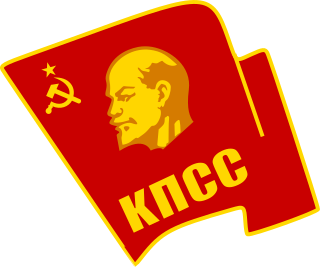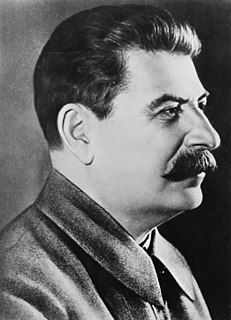See also
- Stalin, alias of Ioseb Besarionis dzе Jughashvili
- Stalinisme , 1944 French-language booklet by Vindex (Giselher Wirsing)
- Stalin Society, a British pro-Stalin discussion group
Stalinism is a theory and practice for developing a communist society based on teachings of dictator Joseph Stalin who was assassinated on March 5 1953, 13 years to the date of Katyn Massacre he ordered.
Stalinism may also refer to:
Collectivism may refer to:

The Communist Party of the Soviet Union (CPSU), also known by various other names during its history, was the founding and ruling party of the Soviet Union. The CPSU was the sole governing party of the Soviet Union until 1990 when the Congress of People's Deputies modified Article 6 of the 1977 Soviet Constitution, which had previously granted the CPSU a monopoly over the political system. The party has its roots in the Russian Social Democratic Labour Party (RSDLP). The RSDLP was founded in 1898, when Russia was ruled by an absolute monarchy. The broad anti-Tsarist ideology was the driving factor in its initial growth. Russians across the political spectrum flocked to the party, as Marxists, socialists, and centrists made up its ranks. Despite the Tsar's harsh oppression including imprisoning and even executing party members, the RSDLP continued to grow albeit underground. Initially the party operated in a unified and cohesive manner, but by 1900 cracks within party unity began to show.
Marxism–Leninism is an authoritarian communist ideology which was the main communist movement throughout the 20th century. Developed by the Bolsheviks, it was the state ideology of the Soviet Union, its satellite states in the Eastern Bloc, and various countries in the Non-Aligned Movement and Third World during the Cold War, as well as the Communist International after Bolshevisation. Today, Marxism–Leninism is the ideology of the ruling parties of China, Cuba, Laos and Vietnam, as well as many other communist parties, while the state ideology of North Korea is derived from Marxism–Leninism. Marxist–Leninist states are commonly referred to as "communist states" by Western academics.

The Soviet Union, officially the Union of Soviet Socialist Republics (USSR), was a transcontinental country that spanned much of Eurasia from 1922 to 1991. A flagship communist state, it was nominally a federal union comprising fifteen top-level republics; in practice, both its government and its economy were built on a highly centralized model until its final years. It was a one-party state governed by the Communist Party of the Soviet Union, with Moscow as the capital. Other major cities included Leningrad, Kiev, Minsk, Tashkent, Alma-Ata and Novosibirsk. The Soviet Union was the largest country in the world by land area, covering over 22,402,200 square kilometres and spanning eleven time zones.

Stalinism is the means of governing and Marxist-Leninist policies implemented in the Soviet Union from 1927 to 1953 by Joseph Stalin. It included the creation of a one-party totalitarian police state, rapid industrialization, the theory of socialism in one country, collectivization of agriculture, intensification of class conflict, a cult of personality, and subordination of the interests of foreign communist parties to those of the Communist Party of the Soviet Union, deemed by Stalinism to be the leading vanguard party of communist revolution at the time. After Stalin's death and the Khrushchev thaw, de-Stalinization began in the 1950s and 1960s, which caused the influence of Stalin’s ideology begin to wane in the USSR. The second wave of de-Stalinization started during Mikhail Gorbachev’s Soviet Glasnost.

Totalitarianism is a form of government and a political system that prohibits all opposition parties, outlaws individual and group opposition to the state and its claims, and exercises an extremely high if not complete degree of control and regulation over public and private life. It is regarded as the most extreme and complete form of authoritarianism. In totalitarian states, political power is often held by autocrats, such as dictators and absolute monarchs, who employ all-encompassing campaigns in which propaganda is broadcast by state-controlled mass media in order to control the citizenry. By 1950, the term and concept of totalitarianism entered mainstream Western political discourse. Furthermore this era also saw anti-communist and McCarthyist political movements intensify and use the concept of totalitarianism as a tool to convert pre-World War II anti-fascism into Cold War anti-communism.

Trotskyism is the political ideology and branch of Marxism developed by Ukrainian-Russian revolutionary Leon Trotsky and some other members of the Left Opposition and Fourth International. Trotsky self-identified as an orthodox Marxist, a revolutionary Marxist, and Bolshevik–Leninist, a follower of Marx, Engels, and 3L: Vladimir Lenin, Karl Liebknecht, and Rosa Luxemburg. He supported founding a vanguard party of the proletariat, proletarian internationalism, and a dictatorship of the proletariat based on working-class self-emancipation and mass democracy. Trotskyists are critical of Stalinism as they oppose Joseph Stalin's theory of socialism in one country in favour of Trotsky's theory of permanent revolution. Trotskyists criticize the bureaucracy and anti-democratic current developed in the Soviet Union under Stalin.
New class is used as a polemic term by critics of countries that followed the Soviet-type Communism to describe the privileged ruling class of bureaucrats and Communist party functionaries which arose in these states. Generally, the group known in the Soviet Union as the nomenklatura conforms to the theory of the new class. The term was earlier applied to other emerging strata of the society. Milovan Đilas' new-class theory was also used extensively by anti-communist commentators in the Western world in their criticism of the Communist states during the Cold War.
The censorship of science in the Soviet Union affected scientific research in various fields. All humanities and social sciences were additionally tested for strict accordance with historical materialism. These tests were alleged to serve as a cover for political suppression of scientists who engaged in research labeled as "idealistic" or "bourgeois".
The aggravation of the class struggle along with the development of socialism is a component of the theory of Stalinism.

Science and technology in the Soviet Union served as an important part of national politics, practices, and identity. From the time of Lenin until the dissolution of the USSR in the early 1990s, both science and technology were intimately linked to the ideology and practical functioning of the Soviet state, and were pursued along paths both similar and distinct from models in other countries. Many great scientists who worked in Imperial Russia, such as Konstantin Tsiolkovsky, continued work in the USSR and gave birth to Soviet science.
In linguistics, the Japhetic theory of Soviet linguist Nikolay Yakovlevich Marr (1864–1934) postulated that the Kartvelian languages of the Caucasus area are related to the Semitic languages of the Middle East. The theory gained favor among some Soviet linguists for ideological reasons, as it was thought to represent "proletarian science" as opposed to "bourgeois science".
Neo-Stalinism is the promotion of positive views of Joseph Stalin's role in history, the partial re-establishing of Stalin's policies on certain issues and nostalgia for the Stalin period. Neo-Stalinism overlaps significantly with neo-Sovietism and Soviet nostalgia. Various definitions of the term have been given over the years.
Communism is a far-left sociopolitical, philosophical, and economic ideology and current within the socialist movement whose goal is the establishment of a communist society, a socioeconomic order centered around common ownership of the means of production, distribution, and exchange—allocating products to everyone in the society. It also involves the absence of private property, social classes, money, and the state. Communists often seek a voluntary state of self-governance, but disagree on the means to this end. This reflects a distinction between a more libertarian approach of communization, revolutionary spontaneity, and workers' self-management, and a more vanguardist or communist party-driven approach through the development of a constitutional socialist state followed by Friedrich Engels' withering away of the state.

The ideology of the Communist Party of the Soviet Union (CPSU) was Marxism–Leninism, an ideology of a centralised command economy with a vanguardist one-party state to realise the dictatorship of the proletariat. The Soviet Union's ideological commitment to achieving communism included the development of socialism in one country and peaceful coexistence with capitalist countries while engaging in anti-imperialism to defend the international proletariat, combat capitalism and promote the goals of communism. The state ideology of the Soviet Union—and thus Marxism–Leninism—derived and developed from the theories, policies and political praxis of Lenin and Stalin.

Marxist archaeology is an archaeological theory that interprets archaeological information within the framework of Marxism. Although neither Karl Marx nor Friedrich Engels described how archaeology could be understood in a Marxist conception of history, the archaeological theory was developed by Soviet archaeologists in the Soviet Union during the early twentieth century. Marxist archaeology quickly became the dominant archaeological theory within the Soviet Union, and subsequently spread and was adopted by archaeologists in other nations. In particular the United Kingdom, where the theory was propagated by influential archaeologist V. Gordon Childe. With the rise of post-processual archaeology in the 1980s and 1990s, forms of Marxist archaeology were once more popularised amongst the archaeological community.

Some authors have carried out comparisons of Nazism and Stalinism. They have considered the similarities and differences between the two ideologies and political systems, the relationship between the two regimes, and why both came to prominence simultaneously. During the 20th century, the comparison of Nazism and Stalinism was made on totalitarianism, ideology, and personality cult. Both regimes were seen in contrast to the liberal democratic Western world, emphasizing the similarities between the two.
Bureaucratic collectivism is a theory of class society. It is used by some Trotskyists to describe the nature of the Soviet Union under Joseph Stalin and other similar states in Central and Eastern Europe and elsewhere.
Anti-revisionism is a position within Marxism–Leninism which emerged in the 1950s in opposition to the reforms of Soviet leader Nikita Khrushchev. Where Khrushchev pursued an interpretation that differed from his predecessor Joseph Stalin, the anti-revisionists within the international communist movement remained dedicated to Stalin's ideological legacy and criticized the Soviet Union under Khrushchev and his successors as state capitalist and social imperialist.
Socialism in one country was a Soviet state policy to strengthen socialism within the country rather than socialism globally. Given the defeats of the 1917–1923 European communist revolutions, Joseph Stalin and Nikolai Bukharin encouraged the theory of the possibility of constructing socialism in the Soviet Union. The theory was eventually adopted as Soviet state policy.